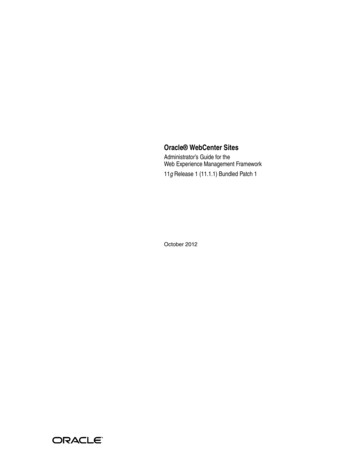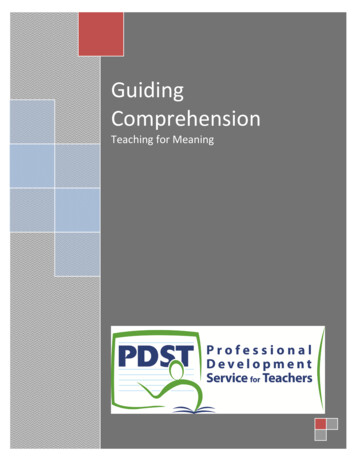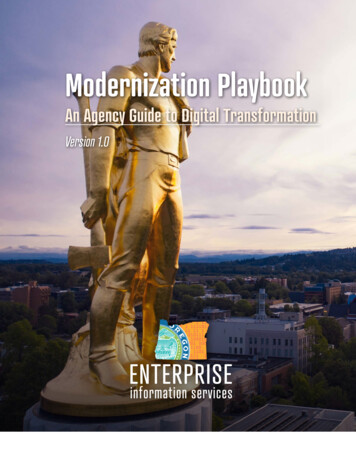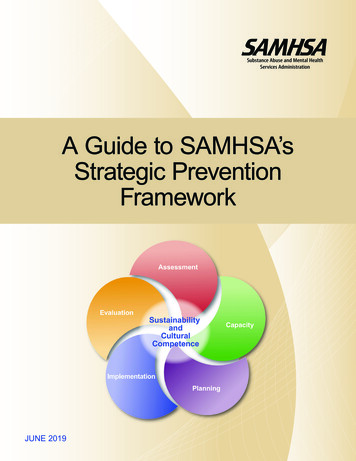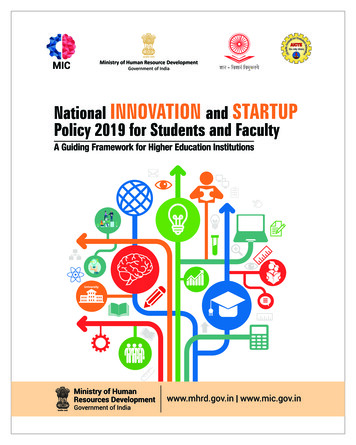
Transcription
AbstractNational INNOVATION and STARTUPPolicy 2019 for Students and FacultyA Guiding Framework for Higher Education InstitutionsThe National Innovation and Startup Policy 2019 for students and faculty of HigherEducation Institutions (HEIs) will enable the institutes to actively engage students, facultiesand staff in innovation and entrepreneurship related activities. This framework will alsofacilitate Ministry of Human Resource Development in bringing uniformity across HEIs interms of Intellectual Property ownership management, technology licensing andinstitutional Startup policy, thus enabling creation of a robust innovation and Start upecosystem across all HEIs.September 11, 2019
lans'kekuo lalkèku fodkl ea ky;jes'k iks[kfj;ky fu'kad*ekuo lla kèku fodkl e a hLVkV&Z vi bfaM;k Hkkjr ljdkjdh ,d çe[qk igy g]S tksuohu vkfo"dkjkas dks gkFk easyus]s lgk;rk vkjS çkRslkgukas dsfoÙk ik"sk.k] m kxs &'k{Skf.kdHkkxhnkjh vkjS bUD;cwVsjkas dscfqu;knh LrHakkas ij vkèkkfjr gASe q s Hkkjr ds lHkh mPp f'k{kklLaFkkukas ds Nk kas vkjS f'k{kdkasds fy, jk"Vªh; uokpkj vkjSLVkV&Z vi uhfr 2019 *ij Bklsfn'kk fun'Zsk tkjh djus dh?kk"sk.kk djrs g,q [k'qkh gks jghgAS ;s fn'kk&fun'Zsk Hkkjr dsgtkjkas rduhdhd‚yts kas ds yk[kkas ;oqkvkas ds euefLr"d eas uokpkj dh Hkkoukdks l'kä djxas s vkjS lLaFkkukasdks u dosy ;oqkvkas ds fy,jkts xkj ds volj inSk djus easenn djxas ]s cfYd Hkkjr ds1mPp f'k{kk lLaFkkukas eas ,detcrw LVkV&Z vi ikfjfLFkfrdhr a fodflr djus ds fy, ,dçjs.kk çnku djxas AseaS pkgrk gaw fd mPprj f'k{kklLaFkkvkas ds fy, fuèkkfZjrfn'kk&fun'Zskkas dks bu lLaFkkvkas}kjk fu;fer çHkko eYw;kda u dslkFk dk;kfZUor fd;k tk, rkfdokfaNr ifj.kkekas dks gkflyfd;k tk ldAseaS Hkkjr ds lHkh mPp f'k{kklLaFkkukas ls vujqkèsk djrk gaw fdos uokpj ;äq cfqu;knh kpa s dsfuek.Zk ds fy, viuk loJZ "sBvkjS vko';d dne mBk,]arkfd gekjs f'k{kk lLaFkkukas easLVkV&Z vi vkjS m e'khyrk dsikfjfLFkfrdh r a dks vfèkdl{ke cuk;k tk ldAs
Message from Ministry of Human ResourceDevelopmentSanjay Shamrao DhotreMinister of State for HumanResource DevelopmentIndia aspires to become a 5trillion dollar economy in anear future. To reach thismark, it needs to evolvesystem and mechanisms toconvert the presentdemographic dividend intohigh quality technical humanresource, capable of doingcutting edge research andinnovation, and deep-techentrepreneurship. At thisjuncture, the MHRD'sInnovation Cell and AICTEhave brought out the‘National Innovation andStartup Policy 2019’ forstudents and faculty.I congratulate MHRD'sInnovation Cell and AICTEfor conceptualizing these2much needed guidelines. Theseenvision an educational systemoriented towards startups andentrepreneurship opportunitiesfor students and faculty. Iappeal all higher educationinstitutions to adopt andpopularize these guidelinesamongst their faculty, staff andstudents, and encourage themto actively pursue path ofinnovation andentrepreneurship.I also urge MHRD'sinnovation cell to proactivelycoordinate with educationdepartments of all stategovernments to ensure thatthese policy guidelines areimplemented in their truespirit.
Message from Ministry of Human ResourceDevelopmentR. SubrahmanyamSecretary (Higher Education)MHRDInnovation andentrepreneurship need toemerge as one of the focalpoints of our educationsystem and Ministry ofHuman ResourceDevelopment is making everypossible effort to achieve thisgoal. We are aggressivelypromoting initiatives likeHackathons, tech-fests, ideacompetition, startupbootcamps, etc. to foster theculture of innovation in oureducation institutions. Wewant large number of studentsand faculty to work on newideas and convert them intosuccessful enterprises.As no formal guidelines were3available for encouragingstudents and faculty to pursestartup and entrepreneurshiprelated activities, a committeewas formed under theguidance of Prof. AshokJhunjhunwala to evolve set ofrecommendations and guidingprinciples for higher educationinstitutions for promotinginnovation andentrepreneurship ecosystemwithin campuses.I firmly believe that therecommendations prescribedin this document will pave theway for developing andsupporting an entrepreneurialculture in all the highereducation institutions of India.
Message from All India Council of TechnicalEducationAnil D SahasrabudheChairman, AICTEI am very happy to see thatthe detailed guidelines havebeen issued by Ministry ofHuman ResourceDevelopment on NationalInnovation and Startup Policyfor students and faculties ofhigher education institutionswhich further strengthens theStartup Policy released by AllIndia Council of TechnicalEducation in November 2016from Rashtrapati Bhawan,just after few months ofStartup action plan announcedby the Government of India inJanuary 2016.I am pleased to share that thepresent policy guidelines arebuilt on the earlier version4published by the AICTE andbeing implemented by theAICTE startup implementationcommittee headed by firstgeneration entrepreneur ShriSanjay Inamdar and coversseveral practical aspects ofinnovation and startups. Theguidelines highlight variousimportant points includingrevenue sharing mechanismfor licensing, ownership of IP,equity sharing mechanismbetween institute and startupsincubated at institute.I wish Ministry of HumanResource Development and allthe educational institutes inIndia a grand success in thismission.
Message from University Grant CommissionD.P. SinghChairman, UGCI am delighted to know thatMinistry of Human ResourceDevelopment has devised theguidelines for promotinginnovation andentrepreneurship amongstudents and faculty of highereducation institutions. Thiswill guide the institutions onthe mechanisms of handholding the students andfaculty members andsupporting their initiatives forinnovations and startups. Thebest universities around theworld have evolved sound5mechanisms for promoting andmanaging innovations. Ibelieve that the ‘Guidelines onNational Innovation andStartup Policy 2019’ willprovide the required directionand support to a large numberof universities and its affiliatedinstitutions in India onhandling Intellectual PropertyRights, innovations and startuprelated issues,I extend my best wishes to theinstitutions for stepping aheadto implement these guidelines.
Message from Chairman, 'National Innovationand Startup Policy 2019' CommitteeAshok JhunjunwalaChairman, NISPCAt the outset, I thank theMinistry of Human ResourceDevelopment for providingme an opportunity to work onthe guidelines with an aim ofnurturing Innovation andStartups ecosystem in highereducation institutions. Myfirm belief is that Incubationand Innovation need to beorganically interlinked.Without innovation, newenterprises are unlikely to6succeed. The goal of theinstitutions should therefore beto link Innovation toEnterprises to financialsuccess.I sincerely congratulate theMinistry of Human ResourceDevelopment for its initiativetowards strengthening ofinnovation and startupecosystem in educationecosystem and wish it a grandsuccess.
Message from Innovation Cell, Ministry ofHuman Resource DevelopmentAt the outset, I would like toacknowledge all committeemembers, without whose activecontributions and support, thesepolicy guidelines would not havebeen possible.Abhay JereChief Innovation Officer,MHRDThese policy guidelines onInnovation and Startups havebeen framed with an aim topromote the innovation andentrepreneurship culture withinour higher education institutions.If India aims to become 5trillion-dollar economy, then itneeds to evolve systems andmechanisms to convert thepresent demographic dividendinto high quality technicalhuman resource capable of doingcutting edge research andinnovation (R&I) and deep-techentrepreneurship.On Global Innovation Index(GII) 2019, India’s rank is 52while China is far ahead of usand ranks 14. ConsideringIndia’s real R&I potential, weshould certainly aspire to bewithin top 25 in next 5 years andit can happen only if we candevelop robust Innovation andentrepreneurship ecosystemwithin our higher educationinstitutions. Moreover,unfortunately at present, none of7our Indian institution figure in top100 global R&I institutions andonly 3 Indian institutions arewithin top 200. This needs tochange and can only happen ifour institutions give substantialemphasis on R&I. In next 5 years,India needs to systematicallywork to ensure that it’s 10institutions are amongst top 100.To ensure that innovation andentrepreneurship emerges as theprimary fulcrum of India’s highereducation systems, MHRD’sInnovation Cell (MIC) isundertaking multiple initiativeslike Smart India Hackathon, AtalRanking of Institutions ofInnovation Achievements(ARIIA), establishingInstitution’s Innovation Councils(IIC) in 1500 institutions,Innovation Competitions, etc.The present National Innovationand Startup Policy is yet anotherstep in that direction. We believethat this policy will immenselybenefit central institutions, stateuniversities and affiliatedinstitutions which are currentlynot well verse at handlingchallenges related to innovation,startup and entrepreneurshipconceived by their faculty andstudents.
MICCommittee for 'National Innovation and Startup Policy2019' Guidelines for Higher Education Institutions1Prof.Ashok JhunjunwalaProfessor, Indian Institute of Technology MadrasChairman2.Shri Sukhbir Singh SandhuAdditional Secretary (Higher Education)Ministry of Human Resource Development New DelhiMember3.Prof. Anil D SahasrabudheChairman, All India Council of Technical Education New DelhiMember4.Dr. Rajnish JainSecretary, University Grants CommissionMember5.Dr. G. RaghuramDirector, Indian Institute of Management BangaloreMember6.Dr. Anand DeshpandeChairman and Managing Director, Persistent Systems, PuneMember7.Dr. Abhay KarandikarDirector, Indian Institute of Technology, KanpurMember8.Dr. Udai B. DesaiDirector, Indian Institute of Technology HyderabadMember9.Dr. Appa Rao PodileVice-Chancellor, University of HyderabadMember10.Dr. Mini Shaji ThomasDirector, National Institute of Technology, TrichyMember11.Dr. Sanjay H InamdarCEO, Flucon Industries & Chairman, AICTE Startup Policy CommitteeMember12.Dr. Uday Kumar YaragattiDirector, MNIT, JaipurMember13.Dr. Gautam BiswasDirector, Indian Institute of Information Technology GuwahatiMember14.Sh. Hiranmay MahantaDirector, Gujarat Technological University Innovation CouncilInvitee15.Dr. Abhay JereChief Innovation Officer, Ministry of Human Resource DevelopmentMember SecretaryPolicy Drafting and Implementation Team16.Mr. Dipan SahuExecutive Consultant, Ministry of Human Resource Development Innovation Cell17.Dr. Pooja RawatInnovation Officer, Ministry of Human Resource Development Innovation Cell8
MICContentPreamble10Vision10National Innovation and Startup Policy 2019 for Students and Faculty11-211Strategies and Governance112Startups Enabling Institutional Infrastructure123Nurturing Innovations and Startups134Product Ownership Rights for Technologies Developed at Institute155Organizational Capacity, Human Resources and Incentives166Creating Innovation Pipeline and Pathways for Entrepreneurs at Institute Level177Norms for Faculty Startups188Pedagogy and Learning Interventions for Entrepreneurship Development199Collaboration, Co-creation, Business Relationships and Knowledge Exchange2010 Entrepreneurial Impact Assessment21Way y24Gazette Notification25-369
MICPreambleIn November 2016, All India Council of Technical Education (AICTE) released a Startup Policy document forAICTE approved institutions, to address the need of inculcation of innovation and entrepreneurial culture inhigher education institutions (HEIs). The policy primarily focused on guiding the AICTE approved institutionsin implementing ‘Startup Action Plan’ of Government of India. Subsequent to release of the Startup policy byAICTE and further interaction & feedback received from education institutions, a need was felt for a moreelaborate and comprehensive policy guiding document, which could be applicable for all the HEIs in India.A fifteen membered committee was constituted by Ministry of Human Resource Development to formulatedetailed guidelines for various aspects related to innovation, Startup and entrepreneurship management. Thiscommittee deliberated on various facets for nurturing the innovation and Startup culture in HEIs, whichcovered Intellectual Property ownership, revenue sharing mechanisms, norms for technology transfer andcommercialization, equity sharing, etc. After multiple rounds of meetings, National Innovation and StartupPolicy 2019 for students and faculties of HEIs were prepared.VisionIndia aspires to become 5 trillion-dollar economy by 2024. To reach the mark, it needs to evolve systems andmechanisms to convert the present demographic dividend into high quality technical human resource capableof doing cutting edge research and innovation and deep-tech entrepreneurship.The 'National Student and Faculty Startup policy 2019' for HEIs is a guiding framework to envision aneducational system oriented towards start ups and entrepreneurship opportunities for student and faculties.The guidelines provide ways to Indian HEIs for developing entrepreneurial agenda, managing IntellectualProperty Rights (IPR) ownership, technology licensing and equity sharing in Startups or enterprisesestablished by faculty and students.In India, innovation is still not the epicenter of education. In order to achieve the cultural and attitudinal shiftand to ensure that ‘Innovation and Startup’ culture is the primary fulcrum of our higher education system apolicy framework and guidelines are the need of this hour. These guidelines will enable institutions to activelysupport their faculty, staff and students to participate in innovation and entrepreneurship (I&E) relatedactivities, thus encouraging students and faculty to consider start ups and entrepreneurship as a career option.These recommendations and guiding principles will also help HEIs in creating their own policy framework, ifrequired.Moreover, these guidelines will facilitate Ministry of Human Resource Development in bringing uniformityacross HEIs in terms of IPR ownership management, technology licensing and institutional startups policy,thus enabling creation of a robust innovation and Startup ecosystem across all HEIs. These guidelines will alsohelp emphasize that the entrepreneurship is all about creating a business, which is financially successful.10
MICNational Innovation and Startup Policy 2019 for Students and Faculty1. Strategies and Governancea.Entrepreneurship promotion and development should be one of the major dimensions of the HEIsstrategy. To facilitate development of an entrepreneurial ecosystem in the organization, specificobjectives and associated performance indicators should be defined for assessment.b.Implementation of entrepreneurial vision at the institute should be achieved through missionstatements rather than stringent control system. The entrepreneurial agenda should be theresponsibility of a senior person at the level of dean/ director/ equivalent position to bring in requiredcommitment and must be well understood by the higher authorities. However, one must understandthat promoting entrepreneurship requires a different type of mindset as compared to other academicactivities. Therefore, this person should be very carefully chosen from someone who understands theindustry and above all business.c.Resource mobilisation plan should be worked out at the institute for supporting pre-incubation,incubation infrastructure and facilities. A sustainable financial strategy should be defined in order toreduce the organizational constraints to work on the entrepreneurial agenda.i.Investment in the entrepreneurial activities should be a part of the institutional financial strategy.Minimum 1% fund of the total annual budget of the institution should be allocated for fundingand supporting innovation and startups related activities through creation of separate ‘Innovationfund’.ii. The strategy should also involve raising funds from diverse sources to reduce dependency on thepublic funding. Bringing in external funding through government (state and central) such as DST,DBT, MHRD, AICTE, TDB, TIFAC, DSIR, CSIR, BIRAC, NSTEDB, NRDC, Startup India,Invest India, MeitY, MSDE, MSME, etc. and non-government sources should be encouraged.iii. To support technology incubators, academic institutes may approach private and corporatesectors to generate funds, under Corporate Social Responsibility (CSR) as per Section 135 of theCompany Act 2013.iv. Institute may also raise funding through sponsorships and donations. Institute should activelyengage alumni network for promoting Innovation & Entrepreneurship (I&E).d.For expediting the decision making, hierarchical barriers should be minimized and individualautonomy and ownership of initiatives should be promoted.e.Importance of innovation and entrepreneurial agenda should be known across the institute and shouldbe promoted and highlighted at institutional programs such as conferences, convocations, workshops,etc.f.Student and faculty startup Policy and action plan should be formulated at university level, which is inline with the current document along with well-defined short-term and long-term goals. Micro actionplan should also be developed by the affiliated institutes to accomplish the policy objectives.11
MICg.Institute should develop and implement I & E strategy and policy for the entire institute in order tointegrate the entrepreneurial activities across various centers, departments, faculties, within theinstitutes, thus breaking the silos.h.Product to market strategy for startups should be developed by the institute on case to case basis.i.Development of entrepreneurship culture should not be limited within the boundaries of theinstitution.i.HEIs should be the driving force in developing entrepreneurship culture in its vicinity (regional,social and community level). This shall include giving opportunity for regional startups,provision to extend facilities for outsiders and active involvement of the institute in definingstrategic direction for local development.ii. Strategic international partnerships should be developed using bilateral and multilateral channelswith international innovation clusters and other relevant organizations. Moreover, internationalexchange programs, internships, engaging the international faculties in teaching and researchshould also be promoted.2. Startups Enabling Institutional InfrastructureCreation of pre-incubation and incubation facilities for nurturing innovations and startups in HEIs institutionsshould be undertaken. Incubation and Innovation need to be organically interlinked. Without innovation, newenterprises are unlikely to succeed. The goal of the effort should be to link INNOVATION to ENTREPRISES toFINANCIAL SUCCESS.a.All HEIs are advised to create facilities within their institution for supporting pre-incubation (e.g. IICsas per the guidelines by MHRD’s Innovation Cell, EDC, IEDC, New-Gen IEDC, Innovation Cell,Startup Cell, Student Clubs, etc.) and Incubation/ acceleration by mobilizing resources from internaland external sources.b.This Pre-Incubation/Incubation facility should be accessible 24x7 to students, staff and faculty of alldisciplines and departments across the institution.c.Pre-incubation facilities may or may not be a separately registered entity or Special Purpose Vehicle(SPV), but we recommend that ‘Incubation cum Technology Commercialization Unit’ (ITCU) shouldbe a separate entity preferably registered under Section-8 of Company Act 2013 or 'Society' registeredunder Society Registration Act with independent governance structure. This will allow more freedomto Incubators in decision making with less administrative hassles for executing the programs related toinnovation, IPR and Startups. Moreover, they will have better accountability towards investorssupporting the incubation facility.d.HEIs may offer mentoring and other relevant services through Pre-incubation/Incubation unitsin-return for fees, equity sharing and (or) zero payment basis. The modalities regarding EquitySharing in Startups supported through these units will depend upon the nature of services offered bythese units and are elaborately explained in Section 3.12
MIC3. Nurturing Innovations and Start upsa.HEIs are expected to establish processes and mechanisms for easy creation and nurturing of Startups/enterprises by students (UG, PG, Ph.D.), staff (including temporary or project staff), faculty,alumni and potential start up applicants even from outside the institutions.b.While defining their processes, institutions will ensure to achieve following:i.Incubation support: Offer access to pre-incubation & Incubation facility to start ups by students,staff and faculty for mutually acceptable time-frame.In case an institute doesn’t have a dedicated facility/ infrastructure of its own, then it may reachout to nearest incubation facilities in other HEIs in order to facilitate access to their students, staffand faculty.ii. Will allow licensing of IPR from institute to start up: Ideally students and faculty membersintending to initiate a start up based on the technology developed or co-developed by them or thetechnology owned by the institute, should be allowed to take a license on the said technology oneasy term, either in terms of equity in the venture and/ or license fees and/ or royalty to obviatethe early stage financial burden.iii. Will allow setting up a start up (including social start ups) and working part-time for the start upswhile studying / working: HEIs may allow their students / staff to work on their innovativeprojects and setting up start ups (including Social Start ups) or work as intern / part-time in startups (incubated in any recognized HEIs/Incubators) while studying / working. StudentEntrepreneurs may earn credits for working on innovative prototypes/Business Models. Institutemay need to develop clear guidelines to formalize this mechanism. Student inventors may also beallowed to opt for start up in place of their mini project/ major project, seminars, summertrainings. The area in which student wants to initiate a start up may be interdisciplinary or multidisciplinary. However, the student must describe how they will separate and clearly distinguishtheir ongoing research activities as a student from the work being conducted at the start up.c.Students who are under incubation, but are pursuing some entrepreneurial ventures while studyingshould be allowed to use their address in the institute to register their company with due permissionfrom the institution.d.Students entrepreneurs should be allowed to sit for the examination, even if their attendance is lessthan the minimum permissible percentage, with due permission from the institute.e.HEIs should allow their students to take a semester/year break (or even more depending upon thedecision of review committee constituted by the institute) to work on their start ups and re-joinacademics to complete the course. Student entrepreneurs may earn academic credits for their effortswhile creating an enterprise. Institute should set up a review committee for review of start up bystudents, and based on the progress made, it may consider giving appropriate credits for academics.f.The institute should explore provision of accommodation to the entrepreneurs within the campus forsome period of time.13
MICg.Allow faculty and staff to take off for a semester / year (or even more depending upon the decision ofreview committee constituted by the institute) as sabbatical/ unpaid leave/ casual leave/ earned leavefor working on startups and come back. Institution should consider allowing use of its resource tofaculty/students/staff wishing to establish start up as a fulltime effort. The seniority and otheracademic benefits during such period may be preserved for such staff or faculty.h.Start a part-time/full time MS/ MBA/ PGDM (Innovation, entrepreneurship and venturedevelopment) program where one can get degree while incubating and nurturing a startup company.AICTE has already issued guidelines for a similar program.i.Institute will facilitate the startup activities/ technology development by allowing students/ faculty/staff to use institute infrastructure and facilities, as per the choice of the potential entrepreneur in thefollowing manners:iShort-term/ six-month/ one-year part-time entrepreneurship training.iiMentorship support on regular basis.iii Facilitation in a variety of areas including technology development, ideation, creativity,design thinking, fund raising, financial management, cash-flow management, new ventureplanning, business development, product development, social entrepreneurship, productcosting, marketing, brand-development, human resource management as well as law andregulations impacting a business.j.ivInstitute may also link the startups to other seed-fund providers/ angel funds/ venture fundsor itself may set up seed-fund once the incubation activities mature.vLicense institute IPR as discussed in section 4 below.In return of the services and facilities, institute may take 2% to 9.5% equity/ stake in the startup/company, based on brand used, faculty contribution, support provided and use of institute’s IPR(a limit of 9.5% is suggested so that institute has no legal liability arising out of startup. The instituteshould normally take much lower equity share, unless its full-time faculty/ staff have substantialshares). Other factors for consideration should be space, infrastructure, mentorship support, seedfunds, support for accounts, legal, patents etc. For staff and faculty, institute can take no-more than 20% of shares that staff / faculty takeswhile drawing full salary from the institution; however, this share will be within the 9.5%cap of company shares, listed above. No restriction on shares that faculty / staff can take, as long as they do not spend more than20% of office time on the startup in advisory or consultative role and do not compromisewith their existing academic and administrative work / duties. In case the faculty/ staff holdsthe executive or managerial position for more than three months in a startup, then they willgo on sabbatical/ leave without pay/ earned leave. In case of compulsory equity model, Startup may be given a cooling period of 3 months touse incubation services on rental basis to take a final decision based on satisfaction of14
MICservices offered by the institute/incubator. In that case, during the cooling period, institutecannot force startup to issue equity on the first day of granting incubation support.k. The institute should also provide services based on mixture of equity, fee-based and/ or zero paymentmodel. So, a startup may choose to avail only the support, not seed funding, by the institute on rentalbasis.l. Institute could extend this startup facility to alumni of the institute as well as outsiders.m. Participation in start uprelated activities needs to be considered as a legitimate activity of faculty inaddition to teaching, R&D projects, industrial consultancy and management duties and must beconsidered while evaluating the annual performance of the faculty. Every faculty may be encouragedto mentor at least one startup.n. Product development and commercialization as well as participating and nurturing of startups wouldnow be added to a bucket of faculty-duties and each faculty would choose a mix and match of theseactivities (in addition to minimum required teaching and guidance) and then respective faculty areevaluated accordingly for their performance and promotion.o. Institutions might also need to update/change/revise performance evaluation policies for faculty andstaff as stated above.p. Institute should ensure that at no stage any liability accrue to it because of any activity of any startup.q. Where a student/ faculty startup policy is pre-existing in an institute, then the institute may considermodifying their policy in spirit of these guidelines.4. Product Ownership Rights for Technologies Developed at Institutea.When institute facilities / funds are used substantially or when IPR is developed as a part ofcurriculum/ academic activity, IPR is to be jointly owned by inventors and the institute.i.Inventors and institute could together license the product / IPR to any commercial organisation,with inventors having the primary say. License fees could be either / or a mix of1. Upfront fees or one-time technology transfer fees2. Royalty as a percentage of sale-price3. Shares in the company licensing the productii.An institute may not be allowed to hold the equity as per the current statute, so SPV may berequested to hold equity on their behalf.iii.If one or more of the inventors wish to incubate a company and license the product to thiscompany, the royalties would be no more than 4% of sale price, preferably 1 to 2%, unless it ispure software product. If it is shares in the company, shares will again be 1% to 4%. For a puresoftware product licensing, there may be a revenue sharing to be mutually decided between theinstitute and the incubated company.b. On the other hand, if product/ IPR is developed by innovators not using any institute facilities, outside15
MICoffice hours (for staff and faculty) or not as a part of curriculum by student, then product/ IPR will beentirely owned by inventors in proportion to the contributions made by them. In this case, inventors candecide to license the technology to third parties or use the technology the way they deem fit.c. If there is a dispute in ownership, a minimum five membered committee consisting of two facultymembers (having developed sufficient IPR and translated to commercialisation), two of the institute’salumni/ industry experts (having experience in technology commercialisation) and one legal advisorwith experience in IPR, will examine the issue after m
promote the innovation and institutions are amongst top 100. entrepreneurship culture within To ensure that innovation and our higher education institutions. entrepreneurship emerges as the If India aims to become 5 primary fulcrum of India’s higher trillion-d




